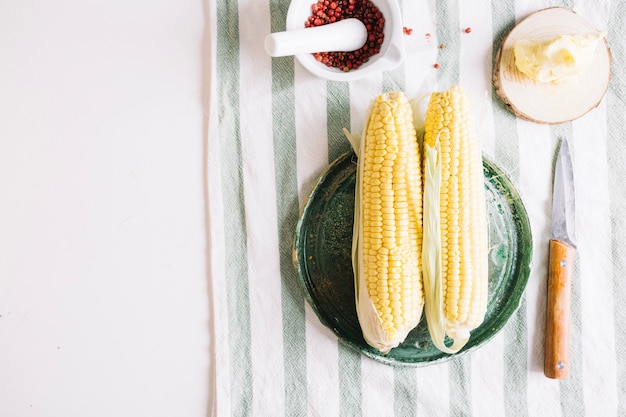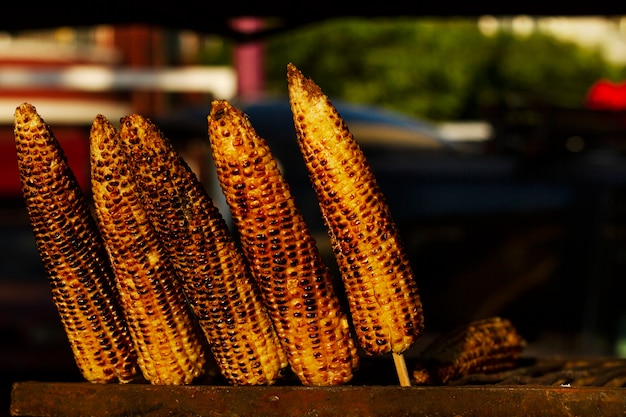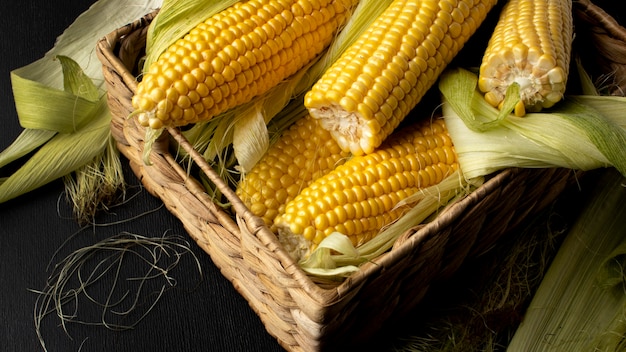As a seasoned foodie, I've spent countless hours in the kitchen, experimenting with different cooking methods. But one thing that always felt a bit daunting was baking corn on the cob. I'd hear tales of dry, flavorless corn, and the idea of it taking forever to cook just didn't appeal to me. Well, let me tell you, my friends, I've finally cracked the code. After numerous trials and tribulations, I've developed a foolproof method that consistently delivers perfect, juicy, and flavorful corn on the cob, baked to absolute perfection. And guess what? It's actually surprisingly simple.
So, gather around, fellow food enthusiasts, and let me share my secrets to baking corn on the cob like a pro.
Part 1: The Right Kind of Corn

Before we even think about the oven, let's talk about the star of the show - the corn itself. The quality of your corn will make a huge difference in the final taste, so choose wisely.
Choosing the perfect corn
The first rule of thumb is to always choose fresh corn. You'll know it's fresh if the husks are tightly wrapped around the ear, the silks are moist and silky, and the kernels are plump and juicy. If you're unsure, give the kernels a little squeeze. They should bounce back with a slight give, not feel mushy.
My personal experience has shown that for baking, corn that's been on the cob for a couple of days after picking works best. It allows the kernels to mature a bit more, leading to a sweeter and more flavorful result. It's like waiting for a ripe mango to reach its peak sweetness - that extra bit of time makes a world of difference. Of course, if you have super fresh corn, that's fantastic too. It'll still be delicious, just maybe not as sweet as the slightly aged corn.
Tips for Selecting Fresh Corn
Here are some additional tips for choosing the best corn:
- Look for vibrant green husks: A bright, deep green color indicates freshness. Avoid corn with brown spots or wilted husks.
- Check the silks: Fresh silks will be moist and silky. If they're dry and brittle, the corn might be too old.
- Feel the kernels: Fresh kernels will be plump and firm. If they feel soft or mushy, the corn is probably past its prime.
Part 2: Preparing the Corn

Once you've got your perfect corn, it's time to prep it for the oven. Now, I know some people prefer to leave the husks on during baking, but I find that it can make the corn a bit dry. So, I always take the husks off. It's actually pretty easy. Just gently peel back the husks and remove the silks. It's a good idea to rinse the corn with cool water to remove any remaining silks and dirt.
Adding Flavor
Now, here's where the fun really begins. Now that the corn is prepped, it's time to add some flavor! I'm a huge fan of butter and salt, but you can get creative. Some people like to add a touch of honey or maple syrup for sweetness, or sprinkle on some herbs like thyme, rosemary, or basil.
My usual method involves rubbing a generous amount of butter all over the corn, followed by a good pinch of salt. You can't go wrong with the classics!
Flavor Variations
Here are a few flavor combinations to inspire you:
- Spicy Sweet: A sprinkle of cayenne pepper and a drizzle of honey add a kick of heat and a touch of sweetness.
- Herbed Delight: A mix of chopped herbs like rosemary, thyme, and oregano infuse the corn with a fragrant aroma.
- Cheesy Corn: A sprinkle of grated Parmesan cheese melts into a delicious, gooey topping.
- Mexican Corn: A blend of chili powder, cumin, and paprika brings a taste of Mexico to your table.
Part 3: The Baking Process

Now comes the part that often gets people worried: the baking itself. Fear not, my fellow food enthusiasts, it's really quite straightforward.
Getting Started
Preheat your oven to 400°F (200°C). Grab a baking sheet and line it with parchment paper. This will prevent the corn from sticking and make cleanup a breeze.
Placing the Corn
Carefully place the corn cobs on the baking sheet. Make sure they're not touching each other, as you want to allow air to circulate and ensure even cooking.
Baking Time
Okay, here's where the magic happens. The baking time for corn on the cob can vary slightly depending on the size and thickness of the ears. But as a general rule, I bake my corn for 20-25 minutes. To check if it's done, simply pierce a kernel with a fork. If the liquid inside runs clear, it's ready to go! If not, bake for another 5-10 minutes.
Keep an eye on your corn while it's baking, as ovens can vary. You might need to adjust the baking time slightly depending on your specific oven.
Part 4: The Art of Serving
Now, you've got perfectly baked corn on the cob. It's time to serve it up!
Time to Eat
When the corn is done baking, take it out of the oven and let it cool slightly. It's hot, but trust me, you'll want to eat it as soon as you can. I usually serve it with a generous pat of butter and a sprinkling of salt.
Serving Suggestions
Here are some ideas for serving your baked corn on the cob:
- side dish: Serve it alongside grilled meats, fish, or vegetables for a complete and satisfying meal.
- Salads: Cut the kernels off the cob and add them to salads for a burst of flavor and texture.
- pasta dishes: Incorporate the kernels into your favorite pasta dishes for a delightful twist.
- Corn Chowder: Create a creamy and comforting corn chowder using the baked kernels.
Part 5: Tips for Success
Over the years, I've learned a few tricks that help guarantee perfect results. Here are my top tips for baking corn on the cob like a pro:
- Use parchment paper: This prevents the corn from sticking to the baking sheet and makes cleanup super easy.
- Don't overcrowd the baking sheet: Give the corn some space so that the hot air can circulate evenly and cook the corn thoroughly.
- Keep an eye on the corn: Every oven is different, so you might need to adjust the baking time slightly based on your oven's temperature.
- Broil for a charred flavor: If you prefer a slightly charred flavor, you can broil the corn for a few minutes after it's baked. Just keep a close eye on it so it doesn't burn!
- Don't overcook: It's best to err on the side of undercooked rather than overcooked. The corn will continue to cook slightly after it's taken out of the oven.
Part 6: Exploring Variations
Now that you've mastered the basics, it's time to have some fun with variations! Here are a few ideas to spice up your corn-baking game:
Sweet and Spicy
For a sweet and spicy kick, try adding a touch of honey and a pinch of cayenne pepper to the corn before baking. It's a delicious combination of sweetness and heat that's sure to please everyone at the table. The honey adds a subtle sweetness that balances out the heat of the cayenne pepper, creating a complex and satisfying flavor profile.
Herbed Delight
If you're a fan of fresh herbs, try rubbing the corn with a mixture of chopped herbs like rosemary, thyme, and oregano. The aromatic flavors will infuse the corn, creating a delightful and fragrant dish. The earthy flavors of rosemary and thyme complement the sweetness of the corn, while the oregano adds a touch of complexity.
Cheesy Corn
For a cheesy twist, sprinkle some grated Parmesan cheese over the corn before baking. The cheese will melt and create a delicious, gooey topping that's perfect for dipping in a side of butter. The sharpness of the Parmesan cheese contrasts nicely with the sweetness of the corn, making for a truly irresistible combination.
Mexican Corn
Get a taste of Mexico by adding a sprinkle of chili powder, cumin, and paprika to the corn before baking. It's a simple but flavorful twist that will transport you to a sunny Mexican cantina. The chili powder adds a touch of heat, the cumin brings an earthy aroma, and the paprika provides a subtle sweetness.
Part 7: Beyond Baking
While baking is a fantastic way to cook corn on the cob, it's not the only method. Here are a few other ways to enjoy this summery treat:
Grilling
grilling corn on the cob is a classic summertime tradition. Simply remove the husks, leaving a few inches of husk at the bottom. Then, soak the corn in water for about 30 minutes. This helps to prevent the corn from drying out while grilling. Grill the corn over medium heat for about 10-15 minutes, turning occasionally, until the kernels are tender and slightly charred. The char adds a smoky depth of flavor, making grilled corn a true summer treat.
Boiling
If you're in a hurry, boiling is a quick and easy way to cook corn on the cob. Remove the husks and silks, then boil the corn in salted water for about 5-7 minutes. This method is perfect for a simple side dish or for using the corn in salads or soups.
Microwave
For a super quick and easy method, you can microwave corn on the cob. Remove the husks and silks, then wrap the corn in a damp paper towel. This helps to steam the corn and prevent it from drying out. Microwave on high for 3-5 minutes, or until tender. This is a great option for a quick snack or for those nights when you don't have much time to cook.
Part 8: Storage and Leftovers
Once you've enjoyed your perfectly baked corn on the cob, you might be left with some leftovers. But don't fret, you can still put those leftovers to good use!
Storing Corn
To store leftover baked corn, simply place it in an airtight container in the refrigerator. It should keep well for 3-4 days.
Using Leftovers
Leftover baked corn can be used in a variety of ways. You can add it to salads, soups, stews, or even use it as a filling for tacos or burritos.
Remember, the key to using leftover corn is to keep it moist. If you find that the corn is starting to dry out, you can refresh it by adding a little bit of water or broth to the container and microwaving it for a few seconds.
Part 9: FAQs
Why is my corn on the cob dry?
There are a few reasons why your corn on the cob might be dry. First, it could be that you're using old corn. Fresh corn will always be juicier and more flavorful. Second, you could be overcooking the corn. Make sure to check the doneness regularly and don't cook it for too long. Finally, you might be using a method that dries out the corn, such as leaving the husks on during baking.
How can I make my corn on the cob sweeter?
To make your corn on the cob sweeter, try using a slightly aged corn (a few days old after picking). Also, adding a touch of honey or maple syrup to the corn before baking can enhance its sweetness.
Can I bake corn on the cob in foil?
Yes, you can bake corn on the cob in foil. However, I prefer to bake it uncovered on a baking sheet. This allows the corn to cook evenly and develop a slightly charred flavor.
What are some good dipping sauces for corn on the cob?
There are many delicious dipping sauces for corn on the cob. Some popular options include melted butter, sour cream, chili powder and lime juice, or even a simple mixture of mayonnaise and paprika.
Can I freeze corn on the cob?
Yes, you can freeze corn on the cob. The best way to freeze it is to blanch it first. Blanching involves immersing the corn in boiling water for a few minutes, then immediately plunging it into ice water. This helps to preserve the corn's color and texture.
Everyone is watching

Perfect Rice Every Time: The Ultimate Guide to Cooking Rice
Cooking TipsAs a self-proclaimed foodie, I've always been a bit obsessed with rice. It's the foundation of countless cuisi...

Prime Rib Roast Cooking Time Chart: Per Pound Guide
Cooking TipsPrime rib roast. Just the name conjures images of lavish dinners, crackling fires, and hearty laughter. It’s ...

The Ultimate Guide to Cooking Asparagus: Tips, Techniques, and Recipes
Cooking TipsAsparagus. The mere mention of this spring delicacy conjures up images of vibrant green spears, crisp and burs...

Ultimate Guide to Cooking the Perfect Thanksgiving Turkey
Cooking TipsThanksgiving. Just the word conjures up images of overflowing tables laden with delicious food, the scent of r...

How Long to Bake Potatoes in the Oven (Perfect Every Time)
Cooking TipsBaked potatoes are a staple in my kitchen. They're incredibly versatile, delicious, and surprisingly easy to m...
